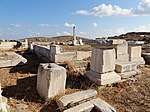Prytaneion
A prytaneion (Ancient Greek: Πρυτανεῖον) was seat of the prytaneis (executive), and so the seat of government in ancient Greece. The term is used to describe any of a range of ancient structures where officials met (normally relating to the government of a city) but the term is also used to refer to the building where the officials and winners of the Olympic games met at Olympia. The prytaneion normally stood in centre of the city, in the agora.
In general in ancient Greece, each state, city or village possessed its own central hearth and sacred fire, the prytaneum, representing the unity and vitality of the community. The fire was kept alight continuously, tended by the king or members of his family. The building in which this fire was kept was the prytaneum, and the chieftain (the king or prytanis) probably made it his residence. The building contained the holy fire of Hestia, the goddess of the hearth, and symbol of the life of the city.
The word prytanis (pl. prytaneis) is generally applied specially to those who, after the abolition of absolute monarchy, held the chief office in the state. Rulers of this name are found at Rhodes as late as the 1st century B.C.
There was also a court of justice called the court of the prytaneum; all that is known of this court is that it tried murderers who could not be found, and inanimate objects which had caused death. Judging from its rather fanciful functions and from its name, it was probably a relic of the archaic jurisdiction of the patriarch-king.
Function
The prytaneum was regarded as the religious and political center of the community and was thus the nucleus of all government, and the official "home" of the whole people. When members of the state went forth to found a new colony they took with them a brand from the prytaneum altar to kindle the new fire in the colony; the fatherless daughters of Aristides, who were regarded as children of the state at Athens, were married from the prytaneum as from their home; Thucydides informs us[1] that in the Synoecism of Theseus the prytanea of all the separate communities were joined in the central prytaneum of Athens as a symbol of the union; and foreign ambassadors and citizens who had deserved especially well of the state were entertained in the prytaneum as public guests. This is the function that Socrates referred to in Plato's Apology when he said that instead of death he should be sentenced to be cared for in the prytaneum.[2]
Polemon of Athens said that copies of the laws of Solon were kept in the prytaneum, engraved on square wooden tablets which revolved on pivots in such a way that when the tablets were turned at an angle they seemed to be triangular. Pausanias says briefly that the laws of Solon were inscribed in the prytaneum.[3]
Athens
The site of the prytaneum at Athens cannot be definitely fixed; it is generally supposed that in the course of time several buildings bore the name. The prytaneum, mentioned by Pausanias, and probably the original center of the ancient city, was situated somewhere east of the northern cliff of the Acropolis. Hence, the frequent confusion with the Tholos, which was near the council chamber and was the residence of the prytaneis of the council.
Ernst Curtius places the original prytaneum south of the Acropolis in the Old Agora, speaks of a second identical with the Tholos in the Kerameikos, and regards that of Pausanias as a building of Roman times. Charles Wachsmuth holds the former view and regards the Tholos as merely a dining-room for the prytaneum in the old democratic period.
Many authorities hold that the original Prytaneum of the Cecropian city must have been on the Acropolis. From Aristotle's Constitution of Athens[4] we know that the Prytaneum was the official residence of the Archons, but, when the New Agora was constructed by Peisistratus, they took their meals in the Thesmotheteum for the sake of convenience. Geoffrey Schmalz suggested in 2006 that the Prytaneum should be identified with some of the ruins in St. Catherine's Square, not far from the Lysicrates Monument.[5] Following the unearthing of an inscription mentioning the Prytaneion, George Kavvadias and Angelos Matthaiou argued in 2014 that it was somewhat to the north and west of the location suggested by Schmalz.[6]
Achaea
In Achaea, this central hall was called the Lefton (town-hall), and a similar building is known to have existed at Elis.
Prytaneion, Olympia
At Olympia, the Prytaneion[7] was where the priests and magistrates lived; the high priests lived in the Theokoleon.[8] It stands to the north-west of the Temple of Hera and was used for celebrations and feasts by the winners of the games.[9] It also housed the Altar of Hestia where the original Olympic flame once burnt.[9]
Prytaneion, Naucratis
Athenaeus, in the Deipnosophistae, writes that in Naucratis the people dine in the Prytaneion on the natal day of the Hestia Prytanitis (Ancient Greek: Ἑστίας Πρυτανίτιδος).[10]
Gallery
References
![]()
- 2.15
- Plato (1860). Plato's Apology and Crito, with notes by W. S. Tyler. NY: D. Appleton & Co. p. 21.
- Frazer, James (1917). Studies in Greek Scenery, Legend and History. London: Macmillan and Company, Ltd. pp. 140.
- Ch. 3
- https://www.academia.edu/7519066/The_Athenian_Prytaneion_Discovered
- https://www.academia.edu/9223744/G_Kavvadias_-_A.P._Matthaiou_A_new_Attic_inscription_of_the_fifth_cent._B.C._from_the_East_Slope_of_the_Acropolis_
- "Project Perseus:", Olympia, Prytaneion (Building)
- "Festivals and Games", Olympia: Pathways to Ancient Myth at Calvin College
- "The Altis", Olympia: Pathways to Ancient Myth at Calvin College
- Athenaeus, Deipnosophists, 4.149
Sources
- Miller, Stephen G. The Prytaneion. Its Function and Architectural Form. Berkeley: University of California Press, 1978.




